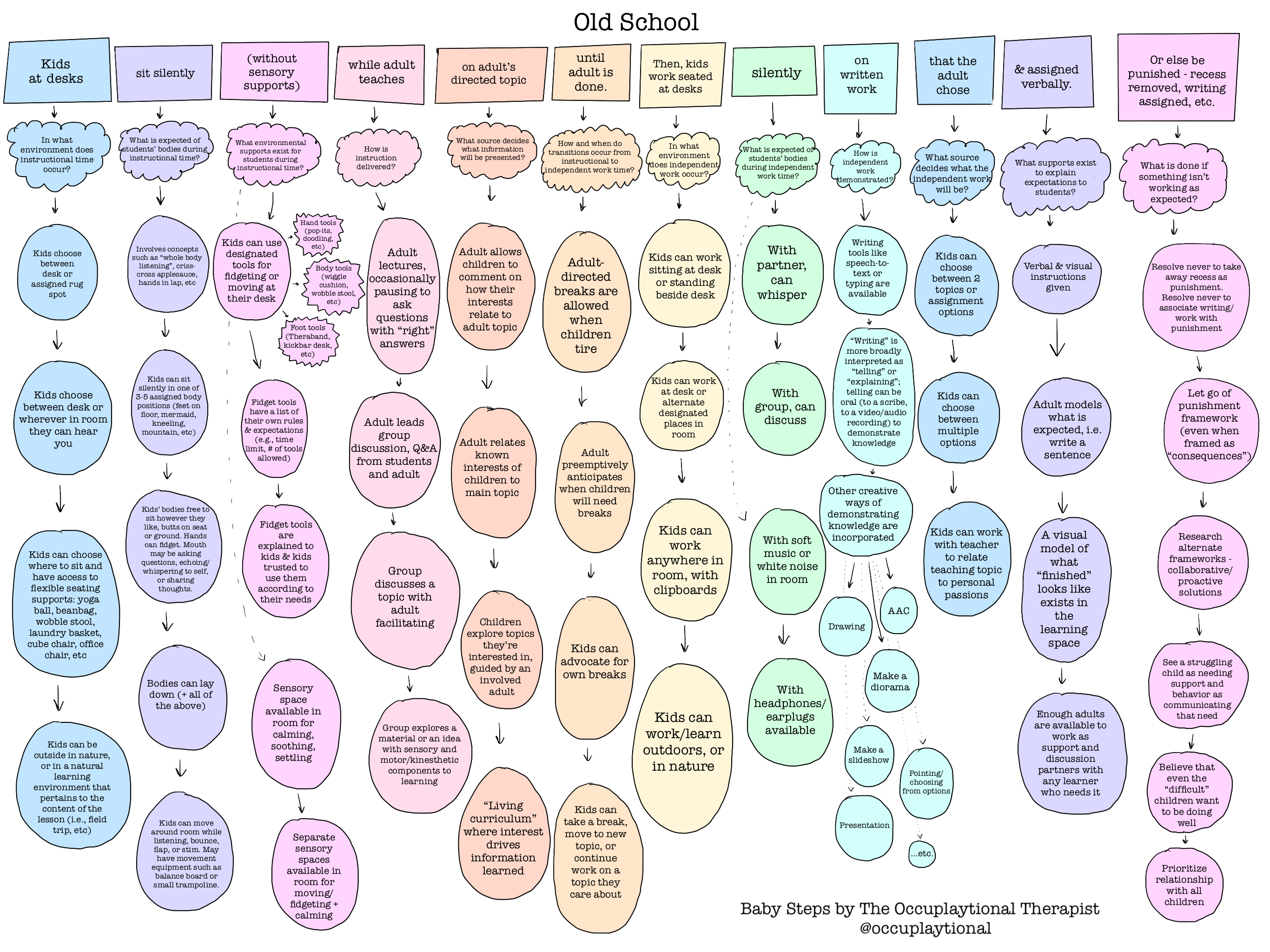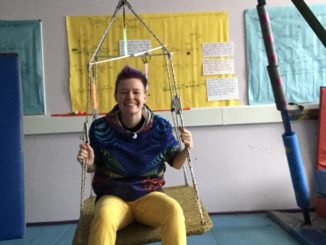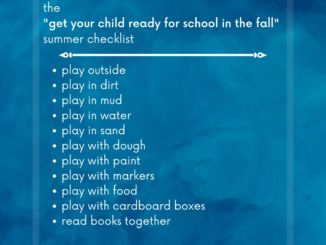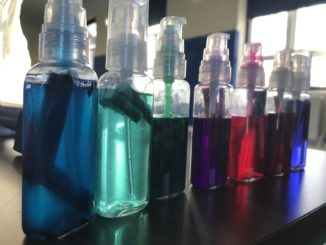
At the top of the poster is a sentence describing “old school expectations”. It reads like this:
“Kids at desks / sit silently / (without sensory supports) / while adult teaches / on adult’s directed topic / until adult is done. / Then, kids work seated at desks / silently / on written work / that the adult chose / & assigned verbally. / Or else be punished – recess removed, writing assigned, etc.”
This long sentence is split up into 12 categories that are describing parts of the “old school” school day: Kids at desks, sit silently, without sensory supports…etc. Each of these 12 categories could be described as an expectation that occurs during the “old school” school day.
Reading down the page, next is a cloud bubble for each category that describes the question that could be asked of that expectation. The cloud bubbles read:
“In what environment does instructional time occur?
What is expected of students’ bodies during instructional time?
What environmental supports exist for students during instructional time?
How is instruction delivered?
What source decides what information will be presented?
How and when do transitions occur from instructional to independent work time?
In what environment does independent work occur?
What is expected of students’ bodies during independent work time?
How is independent work demonstrated?
What source decides what the independent work will be?
What supports exist to explain expectations to students?
What is done if something isn’t working as expected?”
The goal of using this resource would be to identify a box, a category, an expectation, where you want to take a baby step forward in your classroom…
- Contemplate the cloud bubble question and how it relates to the way the expectation takes place in your classroom…
- Identify which of the steps below the box and the cloud closest describes where you’re at in your classroom…
- And ask yourself whether you could take one baby step forward in that category, from the top of the page toward the bottom of the page. From more adult-demanded, to more collaborative. From more restricted, to more free.
Is the goal of this that every single school would be at the very bottom of the page? No. That is not an appropriate use of this resource. Some of these things may not apply to a classroom’s age range. Some of these things may not apply to a classroom’s number of students. Some of these things may not apply to a school setting. This is a very general resource full of dozens of baby step ideas, but it is neither comprehensive nor personalized.
My hope would be that a teacher who teaches 35 fifth-graders could find ONE baby step to take toward a freer, more collaborative classroom.
My hope would be that a teacher who pulls 2 first-grade children at a time for additional reading instruction could find ONE baby step to take.
My hope would be that a teacher who teaches art to high schoolers, and a teacher who has a preschool for children with disabilities, and that a teacher who works at a forest school, and that a teacher who works at a Montessori school, and that a teacher who works at a public school, and that even a parent homeschooling at home, and on and on and on…could all read this, contemplate where they’re at on each thing, and have at least an idea for one area that they could be empowered to take one baby step forward.
I think that the vast, vast majority of schools would probably have a scattered “plot” if they were to plot themselves all across these 12 categories, and I think that that is probably expected. It might differ year to year. It might differ classroom to classroom. You might be empowered by reading this thought process to think of a baby step that isn’t even outlined here.
The goal of it is to give you a quick reference for when you’re feeling like, “I wish X wasn’t like this, but how am I supposed to make any change when I’m constrained by administration, curriculum, parents, class numbers, resources…?” The goal is for you to be able to look at it and confidently say, “Oh, I do think I could change X by one degree, now that I filtered out the interfering factors of W, Y, and Z!”
If you’d like a PDF version to print out or to use digitally, you can get one here: PDF of Baby Steps Poster
Here is the image description/full text version of this poster.
The first category is “Kids at desks…”
The question this expectation is asking is, “in what environment does instructional time occur?”
Down the line from that, these are the baby step suggestions in increasing order of flexibility, unstructuredness, freedom:
- Kids choose between desk or assigned rug spot.
- Kids choose between desk or wherever in room they can hear you.
- Kids can choose where to sit and have access to flexible seating supports: yoga ball, beanbag, wobble stool, laundry basket, cube chair, office chair, etc.
- Kids can be outside in nature, or in a natural learning environment that pertains to the content of the lesson (i.e., field trip, etc).
The second category is “…sit silently…”
The question this expectation is asking is, “What is expected of students’ bodies during instructional time?”
Down the line from that, these are the baby step suggestions in increasing order of flexibility, unstructuredness, freedom:
- Involves concepts such as “whole body listening”, criss-cross applesauce, hands in lap, etc.
- Kids can sit silently in one of 3-5 assigned body positions (feet on floor, mermaid, kneeling, mountain, etc).
- Kids’ bodies free to sit however they like, butts on seat or ground. Hands can fidget. Mouth may be asking questions, echoing/whispering to self, or sharing thoughts.
- Bodies can lay down + all of the above.
- Kids can move around room while listening, bounce, flap, or stim. May have movement equipment such as balance board or small trampoline.
The third category is “…without sensory supports…”
The question this expectation is asking is, “What environmental supports exist for students during instructional time?”
Down the line from that, these are the baby step suggestions in increasing order of flexibility, unstructuredness, freedom:
- Kids can use designated tools for fidgeting or moving at their desk.
- Hand tools (pop-its, doodling, etc)
- Body tools (wiggle cushion, wobble stool, etc)
- Foot tools (theraband, kickbar desk, etc)
- Fidget tools have a list of their own rules and expectations (e.g., time limit, number of tools allowed)
- Fidget tools are explained to kids and kids are trusted to use them according to their needs
- Sensory space available in the room for calming, soothing, settling
- Separate sensory spaces available in room for moving/fidgeting and calming
The fourth category is “…while adult teaches…”
The question this expectation is asking is, “How is instruction delivered?”
Down the line from that, these are the baby step suggestions in increasing order of flexibility, unstructuredness, freedom:
- Adult lectures, occasionally pausing to ask questions with “right” answers
- Adult leads group discussion, Q&A from students and adult
- Group discusses a topic with adult facilitating
- Group explores a material or an idea with sensory and motor/kinesthetic components to learning
The fifth category is “…on adult’s directed topic…”
The question this expectation is asking is, “What source decides what information will be presented?”
Down the line from that, these are the baby step suggestions in increasing order of flexibility, unstructuredness, freedom:
- Adult allows children to comment on how their interests relate to adult topic
- Adult relates known interests of children to main topic
- Children explore topics they’re interested in, guided by an involved adult
- “Living curriculum” where interest drives information learned
The sixth category is “…until adult is done.”
The question this expectation is asking is, “How and when do transitions occur from instructional to independent work time?”
Down the line from that, these are the baby step suggestions in increasing order of flexibility, unstructuredness, freedom:
- Adult-directed breaks are allowed when children tire
- Adult preemptively anticipates when children will need breaks
- Kids can advocate for own breaks
- Kids can take a break, move to new topic, or continue work on a topic they care about
The seventh category is “…Then, kids work seated at desks…”
The question this expectation is asking is, “In what environment does independent work occur?”
Down the line from that, these are the baby step suggestions in increasing order of flexibility, unstructuredness, freedom:
- Kids can work standing at desk or sitting beside desk
- Kids can work at desk or alternate designated places in room
- Kids can work anywhere in room with clipboards
- Kids can work/learn outdoors or in nature
The eighth category is “…silently…”
The question this expectation is asking is, “What is expected of students’ bodies during independent work time?”
Down the line from that, these are the baby step suggestions in increasing order of flexibility, unstructuredness, freedom:
- With partner, can whisper
- With group, can discuss
A separate set of bullet points indicates a second, parallel track of baby steps:
- With soft music or white noise in room
- With headphones/earplugs available
The ninth category is “…on written work…”
The question this expectation is asking is, “How is independent work demonstrated?”
Down the line from that, these are the baby step suggestions in increasing order of flexibility, unstructuredness, freedom:
- Writing tools like speech-to-text or typing are available
- “Writing” is more broadly interpreted as “telling” or “explaining”; telling can be oral (to a scribe, to a video/audio recording) to demonstrate knowledge
- Other creative ways of demonstrating knowledge are incorporated
- Drawing
- AAC
- Make a diorama
- Make a slideshow
- Pointing/choosing from options
- Presentation
- …etc.
The tenth category is “…that the adult chose…”
The question this expectation is asking is, “What source decides what the independent work will be?”
Down the line from that, these are the baby step suggestions in increasing order of flexibility, unstructuredness, freedom:
- Kids can choose between 2 topics or assignment options
- Kids can choose between multiple options
- Kids can work with teacher to relate teaching topic to personal passions
The eleventh category is “…& assigned verbally…”
The question this expectation is asking is, “What supports exist to explain expectations to students?”
Down the line from that, these are the baby step suggestions in increasing order of flexibility, unstructuredness, freedom:
- Verbal & visual instructions given
- Adult models what is expected, i.e., write a sentence
- A visual model of what “finished” looks like exists in the learning space
- Enough adults are available to work as support and discussion partners with any learner who needs it
The twelfth and final category is “Or else be punished – recess removed, writing assigned, etc.”
The question this expectation is asking is, “What is done if something isn’t working as expected?”
Down the line from that, these are the baby step suggestions in increasing order of flexibility, unstructuredness, freedom:
- Resolve never to take away recess as punishment. Resolve never to associate writing/work with punishment
- Let go of punishment framework (even when framed as “consequences”
- Research alternate frameworks – collaborative/proactive solutions
- See a struggling child as needing support and behavior as communicating that need
- Believe that even the “difficult” children want to be doing well
- Prioritize relationship with all children



